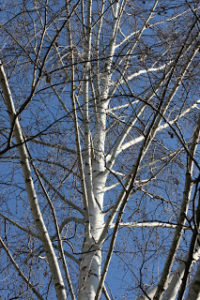Over time many plants and trees have developed strategies to protect themselves and to thrive in their particular climate. Two such strategies, which usually occur in tandem are dormancy and vernalization. Dormancy refers to a period of time when the organism physically stops growing; this is typically done to conserve energy during the colder months of the year or to protect itself from adverse environmental conditions. Plant and tree dormancy that occurs in response to environmental conditions is called consequential dormancy, and predictive dormancy occurs when an organism’s natural biological cycle anticipates a weather change and promotes dormancy in advance. During dormancy deciduous plants will lose all of their leaves and evergreens suspend growth. The picture of the white birch tree below shows a dormant tree that has lost its leaves and is essentially “hibernating” through winter.

Photo of dormant white birch tree courtesy of Jilly Clardy.
Vernalization refers to the period of cold weather exposure experienced by plants and trees, which actually enables them to set buds and produce fruit when warmer temperatures arise. To clarify, dormancy refers to the suspension of the organism’s growth in anticipation or response to environmental change, while vernalization refers to the plants ability to set flowers or produce fruit after dormancy in a direct response to cold weather exposure. If you have stone fruits like peaches and plums or even apples, these all need a vernalization period for them to be able to bear fruits. This is why it is more common to see stone fruits and apples in the Inland Empire than it is too see them along the coast.
Vernalization was discovered after many years of observation by agronomists and plant physiologists. A pioneering researcher in this field, Russian agronomist Trofim Lysenko, coined the term ‘vernalization’ and he also developed methods to manipulate plants which require vernalization to induce early production by artificial exposure to cold temperatures. In fact, Lysenko is credited with saving millions in Russia during a long, cold winter by being able to germinate winter wheat crops ahead of schedule, making food available in the spring instead of the summer.
*You can observe the process of dormancy at your own school. Take a few moments to observe the plants and trees in the garden and note which have lost their leaves and which have not.
*In one of our previous posts we discussed the citrus tree and its unusual characteristic of fruting in winter while many plants are dormant. Do some research to determine if, or when, the citrus tree experiences dormancy.
For more reading on dormancy and vernalization, please see the following websites: http://en.wikipedia.org/wiki/Dormancy
http://ahs.org/publications/the_american_gardener/pdf/0405/Everyday_Garden_Science_51.pdf
http://en.wikipedia.org/wiki/Vernalization
